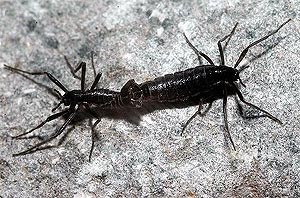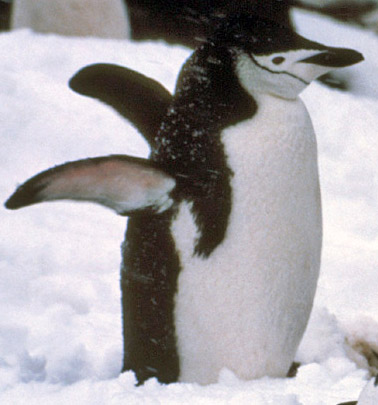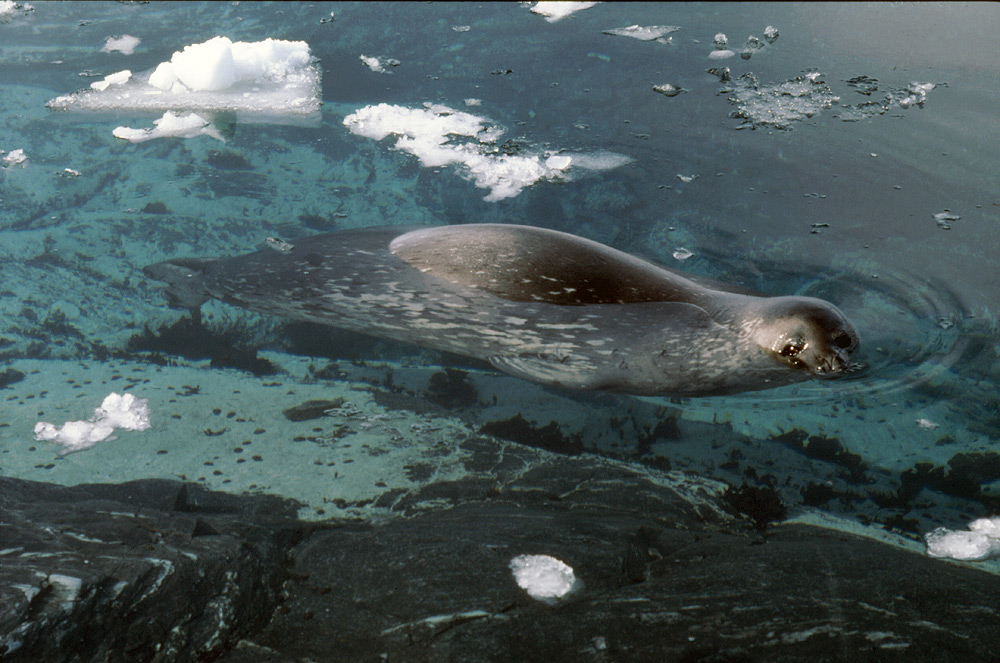How Animals Survive in Cold Conditions
Science of the
Cold
The commonest question asked about polar animals in Antarctica and the Arctic is how do they live and thrive in the extreme cold conditions that are found there?
The Problem
Air temperatures averaging below freezing over the year (usually well below freezing) with a range in many places around -40°C to +10°C (-40°F to +50°F) and highs (very briefly and rarely) up to +22°C (+72°F) amongst rocks and moss banks.
Much of Antarctica is a cold largely featureless icy desert where above freezing temperatures are hardly reached if ever at all. The temperature of the Antarctic Ocean that surrounds the continent varies from -2°C to +2°C (+28.4°F to +35.6°F) over the year. Seawater freezes at -2°C (+28.4°F) so it can't get any colder and still be water.

Snow petrels and a
weddell seal share a tide crack for fishing through
Arctic and Antarctic birds and mammals such as penguins, whales, bears, foxes and seals - are warm blooded animals and they maintain similar internal body temperatures to warm blooded animals in any other climate zone - that is 35-42°C (95-107°F) depending on the species. They have to keep high body temperatures to remain active. These animals are known as endotherms (endo-inside + therm-heat) as they generate their heat internally. The polar regions' cold and wind mean that this heat can very quickly be lost leading to hypothermia (hypo-under).
Many (non polar) animals are ectotherms (ecto-outside) , which means that they generate so little heat internally they are dependent on the external environment to warm them up to a level where their body and enzymes function sufficiently well enough for an active and functional life. Typically they raise their temperature by basking in the sun until they are warm enough to become active. Reptiles and amphibians do this while invertebrates such as insects and spiders are usually small enough to be able to warm up quickly to the ambient temperature from the air alone without basking in direct sunlight.

Emperor penguins breed
in the depths of the Antarctic winter
A large ectothermic Arctic or Antarctic land animal would never get enough energy regularly enough from the surroundings to become sufficiently active once it had cooled. All polar land animals of any size therefore need to be warm-blooded to be active. The environment is so extreme that the size limit in Antarctica for an ectotherm is about 13mm, the size of the largest fully terrestrial (land) animal in Antarctica. In other words any animal larger than this would be unlikely to be able to warm up enough to become active before it started to get cold again.

Weddell seals swim
in water that is 2 degrees C either side of zero, the air temperature
when they leave the sea is often a lot colder
Migration - escape the cold
 Antarctica
is a land mass surrounded by a large very cold ocean,
so unlike the Arctic, purely land-dwelling animals cannot readily
migrate in order to leave the continent in the long, harsh cold
and dark months of the austral winter. The largest purely terrestrial
animal found in Antarctica is a flightless midge that grows
no more than 13mm in length.
Antarctica
is a land mass surrounded by a large very cold ocean,
so unlike the Arctic, purely land-dwelling animals cannot readily
migrate in order to leave the continent in the long, harsh cold
and dark months of the austral winter. The largest purely terrestrial
animal found in Antarctica is a flightless midge that grows
no more than 13mm in length.
All other Antarctic animals are either smaller than this
or migrate spending some of the year away from the deep south
and the extreme cold. They either swim or fly away - and back
again.
The picture shows two wingless midges Belgica
antarctica Antarctica's largest land animal - they
are 13mm long and have to stay where they are year round.
Why do animals go to Antarctica and the Arctic in the first place?
An obvious question when seeing pictures of polar bears, penguins and seals amongst ice strewn oceans or snow and ice fields is why do they go there in the first place?
Antarctic krill
While it's all very picturesque and makes for nice photos
and videos, it's hardly an inviting place to be, especially
if you don't have any shelter or external help (as animals
don't).
The answer is that there is a huge
seasonal supply of food. Due to upwellings of deep
ocean water bringing high levels of nutrients to surface layers
and long day length of up to 24 hours light for months on end
depending on the latitude that results in continuous photosynthesis.
The southern ocean in particular is exceptionally productive.
This productivity starts with phytoplankton, microscopic fast growing and reproducing plants that live in the top layer of the ocean. These are eaten by zooplankton especially Antarctic krill of various Euphausia species, particularly Euphausia superba (pictured).
There is literally millions of tonnes of potential food in the Antarctic Ocean if you are able to catch it and process it efficiently. Large blue whales can catch, eat and process 4 tonnes or more of krill a day for weeks on end in the summer months.
Keeping warm in air and water

The pink blush on this chinstrap penguins' flipper is due to blood being diverted to cool it down on this day when it is just above freezing point. |
Water has a thermal conductivity around 25 times greater than air when still, with movement of the water and convection currents, this can be 50 to 100 times greater than air. This means that you lose heat much quicker in water than air, which you probably knew already.
There is a level called the "lower lethal temperature" which is the temperature at which an organism dies. This temperature in water has never been measured for mammals such as Antarctic seals and whales because it can't be. Even the coldest water (-2°C) doesn't result in death meaning that these animals can live indefinitely in the coldest cold water without suffering from hypothermia, as long as they are well fed.
The skin surface temperature of whales and seals is nearly identical to the surrounding water, though at a depth of around 50mm beneath the skin, the temperature is the same as their core temperature. This is due to the insulating properties of a layer of blubber (fat) under the skin. Blubber insulates in water, fur and feathers insulate in air.
In the air a seals' skin temperature will often rise as it needs to lose heat due to the air being less good at reducing temperature. The skin is well supplied with blood vessels that can shunt blood to the surface or deep within by the constriction or relaxation of tiny muscles that close or open up flow through blood vessels.
Penguins, seals and whales have flippers and flukes (whales tails are called flukes) without blubber that are poorly insulated though well supplied with blood vessels, these too can be used to lose heat when needed. When it is necessary to retain heat, arteries surrounded by veins act as "counter current heat exchangers" to ensure that blood from the body heats blood returning from the flippers, so retaining heat in the core and minimizing heat loss through the flipper or fluke.
Birds have similar counter-current heat exchangers in their legs so they don't lose heat when swimming in frigid water. Like the seals and whales, the muscles required to operate these are deeper in the warm parts of the body and movements made via cord-like tendons.

Rockhopper flipper
showing how little muscle (red-brown) there is.
Tendons attach
to muscles that are deeper in the penguins body to prevent heat
loss
How warm blooded animals stay that way - endotherms and the cold
Endotherm - An animal that generates heat from within by metabolic activity (warm blooded). Being able to generate your own heat from within
and maintain a steady body temperature requires two things:
Being able to generate your own heat from within
and maintain a steady body temperature requires two things:-
1 - Taking enough energy in as food to generate
the heat.
2 - Anatomical, physiological and behavioural adaptations to retain the heat generated.
How do endotherms (warm blooded animals) stay warm in extreme cold?
- All - Most
importantly you need to be large to reduce the
loss of heat from your skin, even smaller Antarctic animals
are still pretty big when compared to their more temperate
climate relatives. There needs to be a low surface area
to volume ratio, lots of volume to generate heat, little
surface area to lose it from.
- All - Extremities
tend to be small to prevent undue heat loss (the
surface area volume ratio thing again).
- All - You
need to be well insulated, internally immediately
under the skin with stored fat (blubber) and externally
with fur (the best insulation of all, though not so good
when wet) or feathers.
- All - Eat
lots of high energy easy to digest food to generate
warmth from within. All large animals (from the smallest
birds upwards) in Antarctica are carnivores. Meat is a more
concentrated energy rich source of food than is plant matter
that doesn't grow very well or very widely in Antarctica
except as tiny plankton in the seas which requires extreme
specialization to gather. Food supply is the main problem,
small animals cannot eat enough to keep warm in extreme
cold, they lose heat faster than they can replace it by
releasing energy from food. Antarctic herbivores
are the zooplankton, especially krill, these are
small cold blooded animals and so convert the energy in
phytoplankton into meat more effectively than if they were
warm blooded.
- Some - Huddling
together in large or small groups is a good way of getting
protection from the wind and retaining warmth. The effect
is similar to the many huddled animals having the reduced
surface area of a larger animal. e.g. emperor penguins.
- Some
- Whales and dolphins - never leave the sea,
so little exposure to extremes of air temperature, then
migrating north when the air temperature drops enough to
freeze the sea.
- Some
- Seals - entering the sea at times of extremely
cold air temperatures and high winds, then migrating
north when the air temperature drops enough to start to
make the sea freeze.
- Some - countercurrent heat exchangers in flippers and feet means that these parts are kept at a lower temperature than the rest of the body to reduce heat loss, blood is cooled when it enters and warmed up when it leaves the flipper or foot.
More about how penguins stay warm in the cold.
Ectotherms and the cold - being active with cold blood
Ectotherm - Animals that get heat from the outside (ecto - outside) environment, they cannot generate enough energy from internal metabolic processes to maintain a stable body temperature. Ectotherms
can warm up by basking (as most reptiles do for example) their
activity is determined by the external temperature, when it
gets cooler, they just slow down eventually becoming torpid
(dormant or inactive).
Ectotherms
can warm up by basking (as most reptiles do for example) their
activity is determined by the external temperature, when it
gets cooler, they just slow down eventually becoming torpid
(dormant or inactive).There are no reptiles or amphibians in Antarctica and very, very few terrestrial invertebrates compared to the rest of the world, it is the only continent without ants for example. It's probably the only place where you have to actively go looking for creepy crawlies, and look quite hard too.
The largest truly land animal in Antarctica is a wingless fly about 13mm in length, this and other similar invertebrates are inactive for much of the time. When the sun comes out and warms them up (or rather their surroundings as they will be hidden away somewhere), they become active for a few hours as long as the temperature remains high enough, cooling down even below freezing point when it becomes colder. As they are so small, they can warm up quickly, if they were larger, they wouldn't have warmed up to active temperature before the external temperature started to drop again.
These animals have lives of temperature dependent stop-go, the stop part can last for days, weeks or months, the go part can be just a few hours. They live in and amongst rocks, moss and other vegetation. Were they any larger or if they came out into the open, they would be easy prey for birds, especially if the temperature dropped causing them to slow down while the warm blooded animals could remain active.
The Sea
The Antarctic Ocean is cold but the temperature is very stable varying between -2°C and +2°C (+28.4°F - +35.6°F) over the year. It can go down to nearly -2°C (actually -1.9°C) before it freezes because the dissolved salt reduces the freezing point of sea-water.
The Antarctic Ocean has been at this temperature for around 20 million years giving plenty of time for plants and animals that live there to become adapted to life in temperatures that would cause most aquatic animals to simply slow down to a state of near torpidity (or suspended animation).
That they can do this is down to having very specialized cold temperature adapted enzyme systems, many Antarctic marine species are as active at 0°C as their temperate counterparts are at 20°C. Cool the temperate species down and they virtually stop - however warm the Antarctic species up and they soon start to suffer, finding life at even +5°C difficult and most probably dying not long after this and way before reaching 20°C.
Many species of Antarctic fish have anti-freeze in their blood, not so much against the temperature per-se as against touching ice which at low temperatures could cause a nucleation point making the ice spread through their cooled bodies. These anti-freezes are large glycoprotein molecules that surround any small ice crystals that may form, so preventing their spread throughout the animals tissues which would mean death. They also provide a tiny cushion for the end of sharp ice crystals so they are less likely to puncture cell membranes.
Interestingly only fish that are likely to encounter ice have these anti-freezes, deeper living fish way below the level of floating ice don't have anti-freeze, some have a freezing point above that of the sea-water in which they live, and really should be frozen solid. They spend their entire lives in a state of being "supercooled" that is, at a temperature that is below their freezing temperature. They can do this as they never come into contact with ice crystals, ice is only found in the upper reaches. If these fish are brought to the surface where they can come into contact with ice, the ice will cause a nucleation point that spreads in their bodies causing instant freezing and death.
Words
There are many words used to describe the ability
of animals to maintain their body temperature. Some are infrequently
used these days but all are still used at some time or other.
The basic distinction is between animals such as
birds and mammals that maintain a stable core temperature of
around 35-42°C irrespective of the environmental temperature
and those whose temperature is variable, more closely reflecting
the environmental temperature.
The reason that the nomenclature
is not straightforward is that there are animals that refuse
to sit cleanly in one of the two apparently obvious categories.
Some organisms clearly didn't read the rules and sometimes
make bits of themselves warmer than other bits irrespective
of the ambient temperature or manage to maintain a stable internal
temperature without necessarily generating that heat internally.
-
Warm blooded
- Animals that maintain a stable warm core temperature of
around 35-42°C, the temperature is species dependent and
often very precise, it is 37°C in humans, a degree or two
more or less will cause us major problems.
Endotherm - Animals that generate heat from within by metabolic activity, usually this means that they can maintain a stable core temperature of around 35-42°C. The term can also apply some of the time to fish such as tuna that are able to maintain their active swimming muscles at 20°C or so above the temperature of the rest of their body by means of counter-current heat exchangers in their circulatory system, this keeps the swimming muscles warm so they work better and prevent heat loss to the rest of the body.
Homeotherm - homo-same, therm-heat, an animal that maintains a stable warm body temperature.
Cold blooded - Animals that have a body temperature the same as the environmental temperature and are unable to warm it above this, not necessarily actually cold if the external temperature is high.
Ectotherm - Animals that cannot generate enough energy from internal metabolic processes to maintain a stable body temperature, most of the heat to warm them up comes from outside of the animal.
Poikiliotherm - An animal whose internal temperature varies quite considerably (a little used term any more).
Heliotherm - An organism that warms itself up by basking in the direct rays of the sun.
Heterotherm - hetero-other, therm-heat, an animal that differs in its body temperature at different times.
It is possible that more than one of these terms may apply to a particular animal at different times, which could be daily or annually.
Picture credits, copyright pictures used by permission: Emperor penguins top of page - Warner Brothers / Killer whales - NOAA




